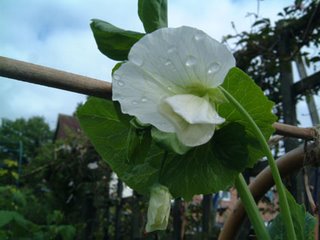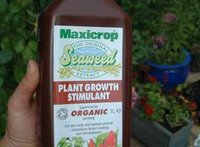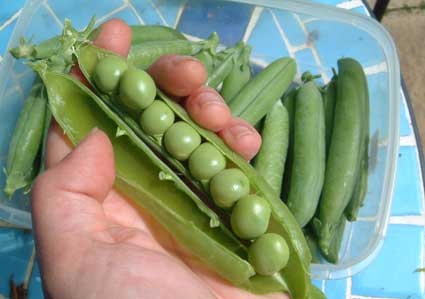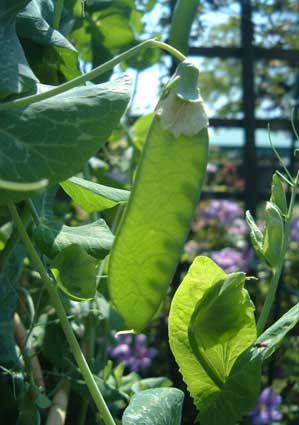 Large flowers are a feature of the Alderman pea
Large flowers are a feature of the Alderman peaI was expecting Alderman to be tall, but I no longer have anything long enough to measure it with. It's exceeded all expectations, including those stated on the seed packet. It reached about 8ft before starting to droop a tiny bit at the top, which is quite impressive because its support cage is only just over 4ft high. The top halves of the plants are standing up on their own.
"What the heck did you put on them?" I hear you ask.
Uh, some of this.

And lots of this.

And a few grass cuttings as a mulch.
Alderman is wonderful. I've grown peas many times before and I've never had anything like this. All my previous crops have been standard varieties. Growing tall Victorian types for the first time I've found them to be superior on just about every level. Although they're meant to be shelling peas they are just as good if you pick them when they're still flat and eat them as mangetout (they remain stringless until quite a late stage) so they are effectively a dual-purpose pea. The pods grow at a height that makes them easy to pick (well away from the soil and the slugs) and they keep cropping prolifically for several weeks, producing an average of nine very large peas per pod. The flavour is absolutely bloody out of this world. Even the mature pods taste good eaten raw, straight off the plant, if you peel off the fibrous layer on the inside. The plants are fast-growing and untroubled by pests, so they're particularly well suited to organic culture.

As I mentioned in a previous post, the variety was introduced by Laxton's in 1891 and was developed from another old variety called Duke of Albany (now rescued from apparent extinction by the HDRA). One observation I've made ... some sources of information suggest that Alderman bears its pods in pairs. Mine have all been produced singly. Not that I'm complaining, because the yields are very generous. The photo above shows one day's harvest (35-40 pods) from my plants, which occupy an area of land only 2ft by 5ft. As you can see, the mature peas are so huge they're trying to squish each other out of the pod. And even when they reach this size they remain exquisitely sweet. If you pick them younger they taste unbelievable.
 Another reason to grow tall peas. You can see the developing peas inside the pods when the sun shines through them. No more harvesting big fat succulent pods only to find that the peas inside are the size of pimples.
Another reason to grow tall peas. You can see the developing peas inside the pods when the sun shines through them. No more harvesting big fat succulent pods only to find that the peas inside are the size of pimples.Alderman is one of the most readily available of the heritage peas. That doesn't mean you'll find it in the average garden centre, unfortunately, but you can certainly get it from The Organic Gardening Catalogue.
The other two varieties of pea I'm growing this year are harder to find. I got my seeds from the magnificent and ever-bountiful Heritage Seed Library.
I think it's fairly safe to say that Mr Bethell's Purple Podded is one of the less well known pea varieties. A Google search yielded only three hits, two of which were for this blog. So there you go. I have the distinction of being the world's greatest contributor of web information on this variety. And so I proudly present this photo showing the exotic colouring in the leaves, stems and flowers.

The leaves are a pale and rather flat olive green, quite different from other peas I've grown. The purple-maroon colouring is strongest in the leaf axils and in some of the stems and tendrils. Some of the leaves are also flushed or streaked with maroon. Flowers are pink with a darker cerise petal below. They start off very pale pink and darken as they mature, eventually turning blue when they've gone over.
 The flowers go through constant colour changes, finally turning blue
The flowers go through constant colour changes, finally turning blueAlmost nothing seems to be known about it. The HSL catalogue just says it originates from the north of England. Presumably it was named after the person who donated it to the Heritage Seed Library, or the last person who was known to grow it. It's one of several purple peas offered by the HSL but as I've never grown them before I'm not sure how they compare.
Beautiful and colourful though it is, I'm slightly nervous because purple-podded peas have a reputation for being inedible unless you snaffle them up as mangetout. We'll see.
Champion of England (below), originally introduced in 1843 as Fairbeard's Champion of England was much prized throughout the 19th century for its superior vigour and flavour, and became very popular in Canada and the US too. It was bred by William Fairbeard, a nurseryman in Teynham, Kent, who was a highly respected pea specialist of his day. Indeed Charles Darwin wrote to him in 1855 asking for information about cross-pollination and inherited traits in pea varieties, as part of his research for Natural Selection. Darwin had obviously spotted that most plants decline in vigour if they're inbred for too many generations but that peas are one of the few plants that don't suffer from this phenomenon. Even today it's not completely understood, but it's known to be a genetic function, the opposite of hybrid vigour, and is called inbreeding depression. Peas don't succumb to inbreeding depression because they're natural inbreeders, designed to self-pollinate. Their flowers are fully enclosed and pollen is shed directly onto the stigma before the buds have even opened. So even when two varieties are grown together they are unlikely to mingle. Fairbeard told Darwin that accidental cross-pollination between pea varieties was so rare that he didn't take any special precautions to stop it, which confirmed what Darwin had noticed in his own garden. Several decades later peas played a crucial part in the discovery of genetics.

Fairbeard introduced several other acclaimed pea varieties which have slipped into obscurity or extinction. It's taken me two years even to find a source of Champion of England seeds and there's limited information available online. So I'll be sure to post plenty of information and pictures of mine as it matures. At the moment it's just beginning to develop its first flower buds.
Now that all three pea varieties are at the flowering stage I'm going to experiment with some hybridisation. The fact that peas don't naturally hybridise makes it all the more fun (and easier to keep control of). Wouldn't it be nice to cross Alderman with the Purple Podded to see what happens? Pink-flowered Alderman? Purple pods with bigger sweeter peas? To do this I'll have to hand pollinate a few buds. Watch this space.
1 comment:
Thanks for the lovely pics and info. We're renting a house and I have pea vines to care for all of a sudden. One variety still had the little label stake but the others did not, so your pictures were most helpful.
I've heard they like it cool and it's supposed to be 103 here tomorrow, so I'm contemplating hosing the poor things down a few times to keep them cool.
Post a Comment